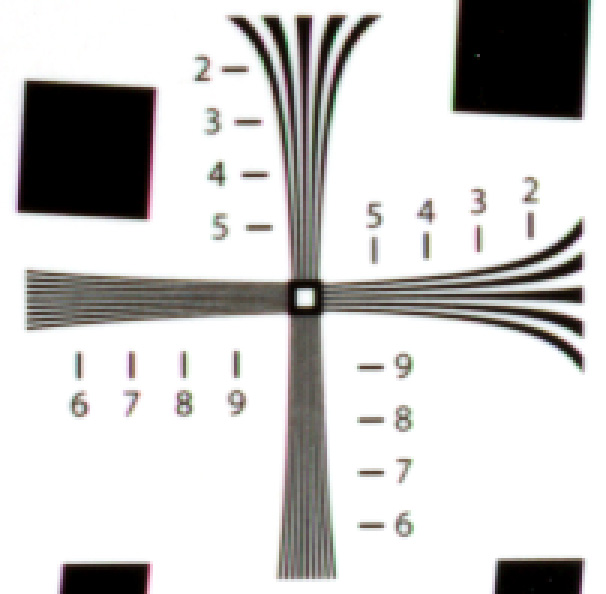There is a focusing aid in the BetterLight software. It allows you to position the sensor column anywhere on the image, read out part of it, and display any channel as a graph. If you’re looking at a high-contrast part of the subject, you can focus by finding the lens positon that maximizes contrast. In addition, assuming that the area that you’re looking at is all in the plane of focus, it’s child’s play to find the aperture that delivers the sharpest image from whatever lens you’re using; just move the aperture lever back and forth until you get maximum contrast. With the 120mm f/5.6 AM ED Nikkor, at the distance that I’m using, f/11 is the magic f-stop.
With more accurate focusing, I was able to get a more contrasty view of the ISO 12233 target. It’s really pretty spectacular. Total ISO 12233 target height is 570 pixels, so one line pair per pixel pair occurs between the lines labeled “5” and those labeled “6”.
So, once you get your head around operating in the field in tethered mode, what’s not to like about the BetterLight back for the firehouse project?
Time, that’s what.
I went back and looked at the exposures for the pictures that I’ve done so far in this series. An average exposure seems to be f/16 for 2 seconds at ISO 100. The lowest ISO for the BetterLight back is 200, and I’d be using f/11 most of the time, so that would give me half a second. But wait! That’s half a second per column, and there are 8000 columns. We’re talking a 4000 second – over an hour – exposure time!
The BetterLight back has a limitation — or is it a feature — that saves me from some of that masochism. The longest exposure time is 1/8 second. I’d have to crank the ISO up to 800, and then I’d have 16-minute exposures.
One, with that long an exposure, my productivity would suck. Two, what are the odds that I’ll be able to keep people from walking someplace where their reflections would be visible for that long? Three, the light is going to change during the exposure. Four, forget focus stacking; even if I had the patience, I’ll never get the light anywhere near the same from image to image.

Leave a Reply